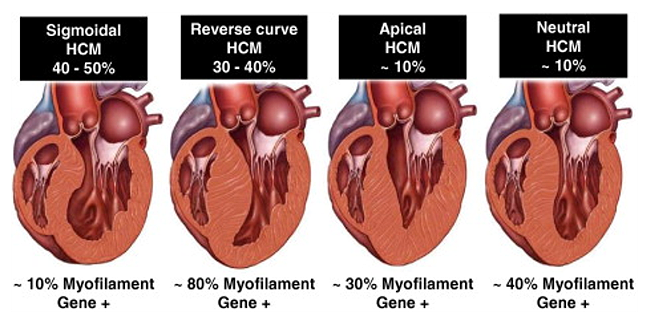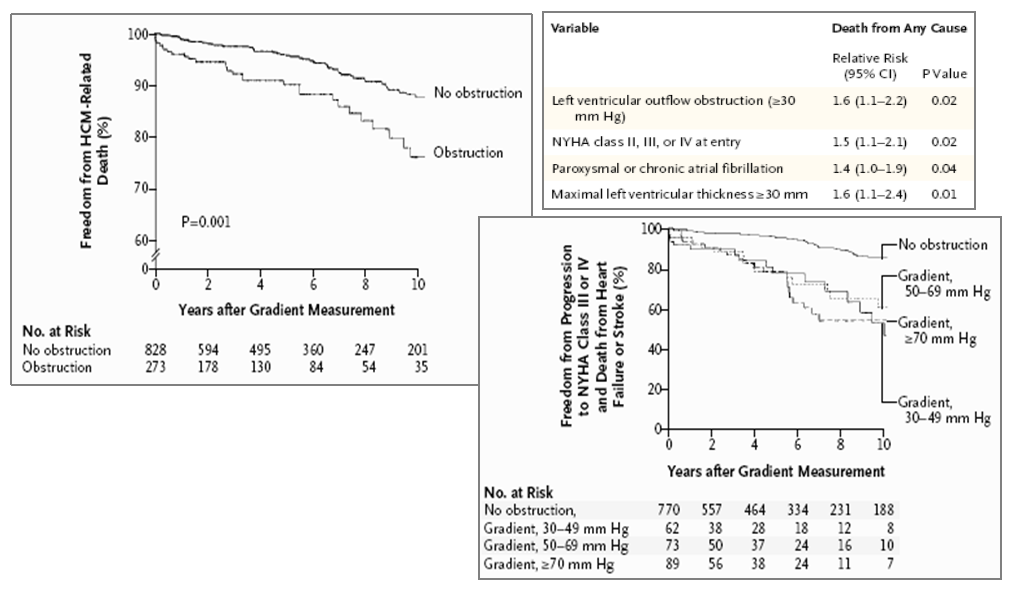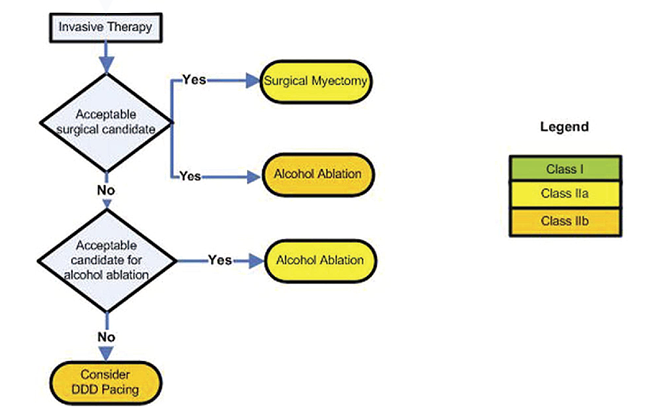Diagnosis and Management of Hypertrophic Cardiomyopathy
Hypertrophic cardiomyopathy, the most common genetic cardiac disease, is present in 1 out of 500 individuals regardless of race or gender, with the prevalence that appears to be increasing in recent years due to the combined effects of heightened awareness, increased utilization of advanced imaging modalities, and genetic testing. The phenotype is one of abnormal hypertrophy, often focal, that may result in various impingements of cardiac function, including diastolic dysfunction, outflow tract obstruction, mitral regurgitation, atrial and ventricular arrhythmia, pulmonary hypertension, coronary insufficiency, and congestive heart failure. While many patients are asymptomatic or mildly symptomatic, or have adapted their physical routine over decades to make the diagnosis of overt disease more subtle, a large subset has significant symptoms that range from palpitations and pre-syncope or syncope to dyspnea, angina and those typical of late or end-stage heart failure. Sudden cardiac death, estimated at 1% per year in this population, may be as high as 3 to 5% in select high-risk subsets, prompting implantable cardioverter-defibrillator (ICD) implantation in roughly 30% of patients.
|
||||||
Symptomatic patients require a thorough evaluation of anatomy and physiology, with an aim to understanding the etiology of symptoms in any given patient. This includes echocardiography to determine extent and location of hypertrophy, presence of anomalous or abnormal papillary muscles, valve pathology or membranes, and the severity of any outflow tract obstruction, both at rest or under physiologic provocation (Figure 1). Cardiac MRI and transesophageal echocardiography are useful when extent of hypertrophy or intramyocardial scar (as represented by late gadolinium enhancement) may aid in decision-making, particularly when the potential benefits of an implantable defibrillator or a better understanding of mitral regurgitation are required, respectively.
It is clinically essential to determine the presence, etiology, and severity of outflow tract obstruction, present in roughly 1/3 of patients under resting conditions and another 1/3 only on provocation. In general, patients with obstructive disease tend to have worse symptoms and life expectancy, whereas a more benign course from a survival standpoint is generally seen in the non-obstructive form (Figure 2). That being said, a significant subset of the latter have severe diastolic dysfunction and progress to requiring heart transplantation, due to the unavailability of other intermediate invasive options or effective medical therapy. Indeed, the mainstay of therapy for such patients has been diuretics to maintain euvolemia, although cardiac output may continue to suffer. Obstructive patients who continue to present severe symptoms of heart failure, pre-syncope/syncope, or angina despite optimal medications may avail themselves of invasive therapies, however, including surgical myectomy or alcohol septal ablation. Permanent pacemaker implantation to minimize obstructive physiology, while possible, has not been proven superior to medical therapy alone in randomized controlled trial experience and is, therefore, no longer recommended solely for this purpose. Its role has been relegated to patients in whom medication optimization are limited by bradycardia or conduction disease, and those in whom septal reduction therapies are relatively or absolutely contraindicated.
Medical management of hypertrophic cardiomyopathy begins with lifestyle modification, including optimal hydration in patients without overt evidence for fluid overload, avoidance of caffeine and alcohol, and appropriate exercise and diet to maintain fitness. Avoidance of competitive athletics in particular is required, as abrupt increases in catecholamines are thought to be a trigger for sudden cardiac arrest. Family counseling and genetic testing are also important, in order to determine the extent of disease in a given family and protect others proactively through appropriately timed testing and counseling.
Asymptomatic patients do not require medications. Once symptomatic, beta-blockers form the first line in those with obstructive disease, while non-dihidropyridine calcium channel blockers are reasonable for the non-obstructive form (Table 1). Little prospective randomized data is available to guide choice, however, and most experts utilize long-active metoprolol in twice-daily formulation for most patients, titrated up to achieve resolution of moderate-severe symptoms without invoking significant side effects or bradycardia. Uptitration of medications and reassessment of symptoms occurs over months and may include adding secondary medications. For example, it is not uncommon to start with beta-blockers, add calcium channel blockers and then consider disopyramide in those without contraindications to its use. It is important to note, however, that large practice variations are present, with some centers electing to proceed to invasive therapies after failure of one or two classes of medications, whereas other centers continue to work with medications until thoroughly exhausted.
Table 1: Pharmacologic Treatment1
- Beta-blockers
- Generally first-line agents (increase diastolic filling and decrease contractility)
- Reduces provocable gradient
- Calcium channel blockers (e.g., Verapamil)
- May cause increased mortality in pts with severe outflow obstruction (Epstein et al, 1981)
- Reduces provocable gradient
- Disopyramide
- Reduces left ventricular (LV) contractility and subaortic gradient, afterload reducer, and slows LV ejection acceleration
- Reduces resting AND provocable gradient
- Diuretics
- HCTZ, dyazide or lasix as needed
|
|||
The accepted indication for invasive therapy is obstructive disease due to systolic anterior motion (SAM) of the mitral valve, obstruction >50 mm Hg either at rest or on provocation, moderate to severe (i.e., Class III angina or heart failure, or recurrent pre-syncope/syncope) symptoms refractory to optimal medical therapy, and the absence of specific procedural contraindications. Choice of invasive therapy is hotly debated. In general, however, surgical myectomy is ideal for younger patients and those with minimal-to-no comorbidities, those with baseline left bundle branch block (LBBB), those with massive or diffuse septal hypertrophy with multiple touch points to the mitral valve leaflet or papillary muscle, those with significant intrinsic abnormality of the mitral or aortic valve that warrants concomitant correction, and those with coronary disease that independently warrants surgical bypass. On the other hand, alcohol septal ablation is ideal for those who are older (especially over the age of 65), with significant or multiple comorbidities, those with baseline right bundle branch block (RBBB), and those with a strong desire to avoid open heart surgery. Acceptable coronary, septum, and mitral valve anatomy is required for a successful alcohol septal ablation procedure, whereas most anatomies can be addressed by an experienced surgeon during a myectomy. Surgical myectomy is given a Class IIa recommendation in guidelines for younger patients and those with acceptable surgical risk, whereas alcohol septal ablation is also a Class IIa for those at higher risk. Patients can also elect for alcohol septal ablation after an informed discussion, as a Class IIb recommendation (Figure 3). Patient choice should also be guided by local procedural results, and although both procedures are often not available at the same institution, care must be taken to refer patients to institutions that have demonstrated high efficacy and excellent safety (in-hospital mortality <1%, clinical efficacy >90%).
Alcohol septal ablation, developed in 1994 as an alternative to surgical myectomy, involves directed infusion of 98% ethanol into a target septal perforator supplying the left ventricular side of the basal septum where systolic contact with the mitral valve is occurring. The addition of myocardial contrast echocardiogram (MCE) guidance has improved such targeting and allowed sub-selective branch injection of smaller aliquots of ethanol, averaging 1-2 cc in the current era. During the procedure, success is evidenced by at least 50% reduction in peak gradient, or residual gradient <20 mm Hg. Complications have markedly reduced as a result, with recent data showing mortality 0.3-0.7% in large observational experience (mirroring surgery in experienced centers), and pacemaker implantation rate of 6-8%. Due to the risk of complete heart block, all patients require transvenous pacemaker insertion and monitoring in the intensive care unit for 48. Although rare, monitoring for ventricular arrhythmia in the first 48 hours is also necessary. Indeed, rates of the latter have decreased markedly due to the lower amount of ethanol utilized and lower rates of inadvertent spillage of alcohol to distant territories in the current era compared to historical controls. Most patients are discharged on day three or four post-procedure.
Long-term outcomes with both alcohol septal ablation and surgical myectomy appear comparable. The main clinical differences between the two procedures involve the surgical risk, longer hospital stay and recuperation, which might include rehabilitation, among those undergoing surgical myectomy, compared to the shorter hospital stay and earlier discharge and less recuperation for alcohol septal ablation. However, studies have shown slightly better gradient reduction with surgery. Functional class improvements are comparable. Interestingly, long-term mortality appears similar between the two procedures in observational experience when controlled for age and gender, with survival roughly 80% at eight years, mirroring the background non-HCM general population. Accordingly, some believe that invasive therapies may in fact impact the natural history of this disease, by alleviating obstruction and effecting beneficial global regression of ventricular hypertrophy and secondary improvements in atrial and ventricular function and the overall heart failure state.
Future studies are needed with regards to the impact of genetic substrate on overt disease, novel pharmacotherapies, better risk stratification models for sudden cardiac death, and a more granular determination of candidacy for either alcohol septal ablation or surgical myectomy. In addition, as current guidelines and competency statements require a minimum of 20 procedures to be proficient, and eight to 10 per year to maintain proficiency, national training courses, and better dissemination of high-quality surgical and interventional techniques to all regions of the country will become paramount.
References
- Gersh BJ, Maron BJ, Bonow RO, et al. 2011 ACCF/AHA guideline for the diagnosis and treatment of hypertrophic cardiomyopathy: executive summary: a report of the American College of Caridology Foundation/American Heart Association Task Force on Practice Guidelines. J Am Coll Cardiol 2011;58:2703-38.
- Khouzam RN, Naidu SS. Current status and future perspectives on alcohol septal ablation for hypertrophic obstructive cardiomyopathy. Curr Cardiol Rep 2014;16:478.
Keywords: Aortic Valve, Arrhythmias, Cardiac, Bradycardia, Bundle-Branch Block, Cardiac Output, Cardiac Surgical Procedures, Cardiomyopathy, Hypertrophic, Catecholamines, Cicatrix, Comorbidity, Coronary Disease, Death, Sudden, Cardiac, Defibrillators, Implantable, Disopyramide, Diuretics, Drug Combinations, Dyspnea, Echocardiography, Transesophageal, Ethanol, Furosemide, Gadolinium, Heart Conduction System, Heart Failure, Heart Transplantation, Hydrochlorothiazide, Hypertension, Pulmonary, Hypertrophy, Life Style, Metoprolol, Mitral Valve, Mitral Valve Insufficiency, Phenotype, Syncope, Triamterene, Ventricular Function, Verapamil
< Back to Listings



